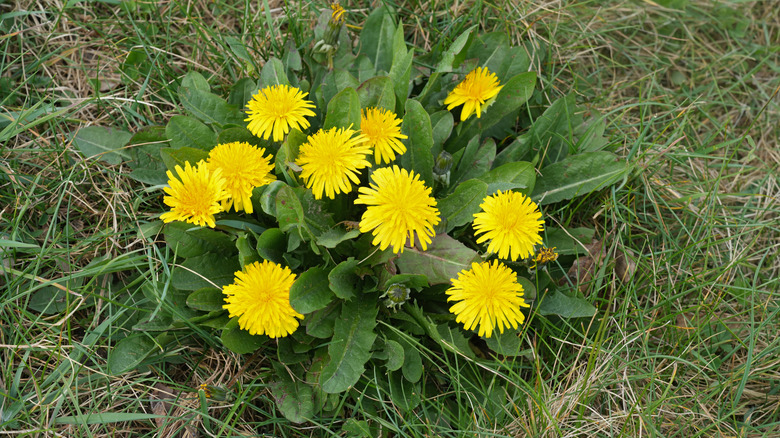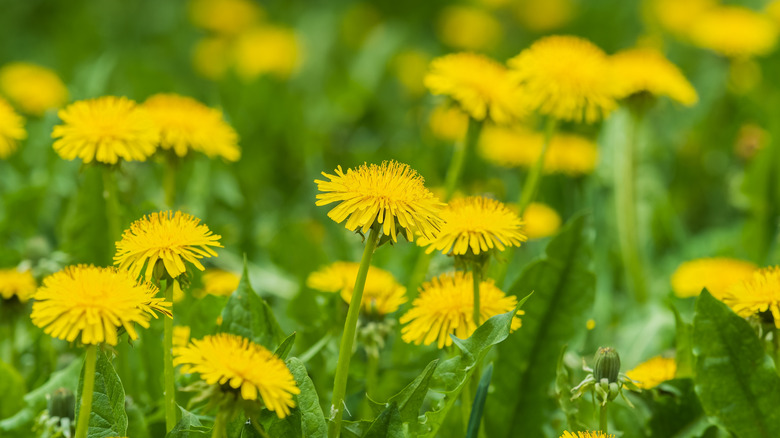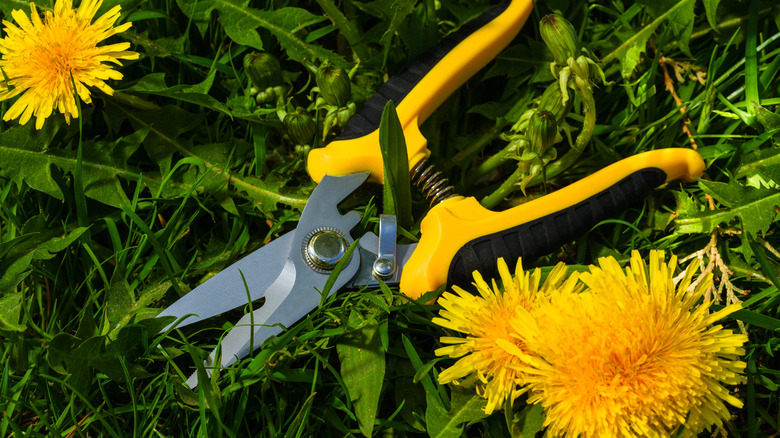How To Create A Controlled Dandelion Patch For Pollinators
An abundance of dandelions is generally considered to be a sign of a messy, unkempt, and unhealthy lawn. After all, dandelions are weeds, and the more weeds you have, the weaker your grass likely is. On the other hand, there are benefits of having dandelions in your yard, and it doesn't have to be an either/or proposition: By creating a controlled dandelion patch, you can enjoy the best of both worlds.
Dandelions are a bit of a double-edged sword for lawns. On the one hand, they compete with grass for nutrients and sunlight; they especially thrive in poor, compacted soil where grass may struggle. On the other hand, their deep taproots aerate the soil and bring nutrients and oxygen up from below. And for pollinators, dandelions are a helpful food source in early spring when few other flowers have bloomed yet. They also have potential medicinal uses, and the leaves and roots can be eaten or used to make tea.
Still, dandelions are considered a weed for a reason – they grow so quickly and prolifically that they often pop up in unwanted places. So how do you create a patch of dandelions that doesn't turn into a full-blown yard full of dandelions? After picking a designated area for these maligned plants, the most important step of all is to deadhead them each year.
Starting a dandelion patch in your yard
Since dandelions can grow pretty much anywhere, whether in full sun or partial shade, you have your pick of the yard for a dandelion patch. You might choose to go with an area where they're already growing. Another option is to plant them near your vegetable beds to encourage pollinators to visit your crops. If needed, you can collect or buy dandelion seeds and plant them in the desired area after the last hard frost of the spring; the soil should be at least 50 degrees Fahrenheit. If you plan to eat the greens, space them out by about 3 inches and plant them in partial shade in fertile soil. They shouldn't need much attention — regular waterings are best, but they can tolerate a bit of drought.
The next step is killing the dandelions in your yard outside of the designated patch. Use a weed-pulling tool to ensure you get that deep tap root out. Otherwise, they will grow right back. If possible, do this while the plants are young and the soil is moist, as it'll be easier. It's also important to keep your lawn healthy with regular watering and fertilization, as healthy grass can easily outcompete dandelions. You can spray natural or synthetic herbicides if necessary, but use with caution and check the potential side effects.
Other tips for maintaining your lawn's new dandelion patch
It's important to take the time to deadhead the dandelions in your patch every year before they go to seed. Removing the spent flowers is absolutely essential, as dandelions produce up to 20,000 seeds per plant and the wind spreads them far and wide; your dandelion patch will quickly grow out of bounds if you allow the plants to produce seeds.
The best way to support local pollinator populations is to add additional wildflowers to your patch rather than just dandelions. Pollinators such as bees need a variety of flowers in a healthy diet, and dandelion pollen is not as nutritious as many other flowers. Look for a wildflower seed mix for your gardening zone (or make your own) and sow it in your patch in the spring.
For example, other early-blooming native flowers include wild lupine (Lupinus perennis), marsh marigold (Caltha palustris), and prairie dandelion (Nothocalais cuspidata), among others. Luckily, dandelions don't typically pose a threat to these native species. Despite their weediness, they're not usually considered invasive because they compete best in mowed, disturbed areas where other perennials can't grow as easily.


